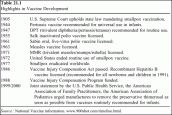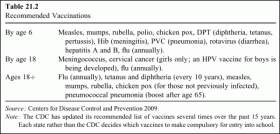Milestones in vaccine history
It was almost 100 years after Jenner’s seminal work that vaccination moved beyond smallpox. The French chemist, Louis Pasteur, developed what he called a rabies vaccine in 1885, but technically what he produced was a rabies antitoxin that functioned as a postinfection antidote.[10] By the 20th century, advances in the science of virology bacteriology and immunology led to a better understanding of how the human body defends itself against invading microorganisms.
Development of viral vaccines and bacteria-based vaccines flourished: the development of vaccines against more than 20 diseases has affected disease morbidity and mortality. Since 1980, more than 15 new or improved vaccines have been approved as a result of advances in molecular biology and genetics, which led to new and improved subunit vaccines that promise to offer increased safety and efficacy. (See table 21.1 for a listing of some of the highlights in history of vaccine development and table 21.2 for a listing of currently recommended childhood vaccinations.)
PERTUSSIS AND DIPHTHERIA
Although the causative agent of pertussis (whooping cough) was isolated in 1907, it was not until the late 1920s that the first whole-killed pertussis vaccine was introduced.[11] Pertussis, particularly serious among infants, is a contagious respiratory disease caused by the B. pertussis bacterium and spread by coughing or sneezing. Toxins produced by B. pertussis can cause high fever, convulsions, brain damage, and death.
Diphtheria, also caused by a bacterium, is a contagious and potentially lifethreatening infection that usually attacks the throat and nose. In more serious cases, it can attack the nerves and heart. Although he survived smallpox, George Washington may have died of diphtheria. In the mid-1930s, a vaccine against pertussis and diphtheria was developed and was later modified in 1947 to include tetanus (the diphtheria, pertussis, and tetanus [DPT] vaccine). In the 21st century, the DPT shot is among the first that an infant receives after birth. A child needs five DPT shots,
given at specified intervals, to ensure complete protection.
 Highlights in Vaccine Development
Highlights in Vaccine Development
Unfortunately, after the DPT booster vaccine became widely used, serious adverse reactions including convulsions, brain damage, and even death were noted in a tiny percentage of children who were vaccinated. In particular, the pertussis component of the DPT vaccine was identified as causing problems in some children. As a result, children with a history of convulsions or neurological disease were strongly advised not to be vaccinated.[12-14] Although serious acute neurologic illness was a rare event, the Institute of Medicine (IOM) was mandated by Congress to study the issue. In 1991, the IOM issued its report and concluded that the evidence was insufficient to indicate a causal relation between DPT and neurologic damage.[15]
Disease Prevention through Vaccination
- The Science and the Controversy
- What are vaccines and how do they work?
- It all started with compox
- Milestones in vaccine history
- Pertussis & Diphtheria
- Polio
- Measles, Mumps and Rubella
- Influenza
- Hepatitis
- Pneumococcal Pneumonia
- Human papillomavirus (HPV)
- The importance of vaccination and resistance to it
- Protesting vaccines: Fact or Myth
- Ensuring vaccine safety and monitoring
- New challenges
The National Childhood Encephalopathy Study (NCES) also found that children who experienced rare but serious acute neurologic disorders within seven days of receiving DPT were no more or less likely to experience documented chronic nervous system dysfunction or to have died within 10 years of the acute disorder than children who had not received DPT within seven days before the onset of the disorder.[16] In sum, no special characteristics were associated with acute or chronic nervous system illnesses linked to DPT exposure. But, the public’s trust was shaken.
Table 21.1
Highlights in Vaccine Development
- 1905 U.S. Supreme Court upholds state law mandating smallpox vaccination.
- 1944 Pertussis vaccine recommended for universal use in infants.
- 1947 DPT (trivalent diphtheria/pertussis/tetanus) recommended for routine use.
- 1955 Salk inactivated polio vaccine licensed.
- 1961 Sabin oral, live-virus polio vaccine licensed.
- 1963 Measles vaccine licensed.
- 1971 MMR (trivalent measles/mumps/rubella) licensed.
- 1972 United States ended routine use of smallpox vaccine.
- 1977 Smallpox eradicated worldwide.
- 1986 Vaccine Injury Compensation Act passed. Recombinant Hepatitis B vaccine licensed (recommended for all newborns and children in 1991).
- 1988 Vaccine Injury Compensation Program funded.
- 1999/2000 Joint statement by the U.S. Public Health Service, the American Association of Family Practitioners, the American Association of Pediatrics urged manufactures to remove the preservative thimerosal as soon as possible from vaccines routinely recommended for infants.
Source: National Vaccine information. www. 900shot.com/timeline.html.
###
Tony Rosen, MPH, MD
Tony Rosen, Division of Geriatric Medicine and Gerontology, Weill Cornell Medical College, Cornell University, New York, New York;
###
REFERENCES
- Barquest N, Domingo P. Smallpox: the triumph over the most terrible of the ministers of death. Ann Internal Med. 1997;127:627.
- US Centers for Disease Control and Prevention. Ten great public health achievements in the twentieth century, 1900-1999.
- Parker AA. Implications of a 2005 measles outbreak in Indiana for sustained elimination of measles in the United States. New Engl J Med. 2006;355:1184.
- Okonek BAM, Peters PM. Vaccines: how and why
- Baxby D. Vaccination: Jenner’s Legacy. Berkeley, UK: Jenner Educational Trust; 1994. 6. Parish HJ. A History of Immunization. Edinburgh, UK: Livingstone; 1965.
- Gross CP, Sepkowitz K. The myth of the medical breakthrough: smallpox, vaccination, and Jenner reconsidered. Int J Infect Dis. 1998;3:54-60.
- Salmon DA, et al. Compulsory vaccination and conscientious or philosophical exemptions: past, present, and future. Lancet. 2006;367(9508):436-442.
